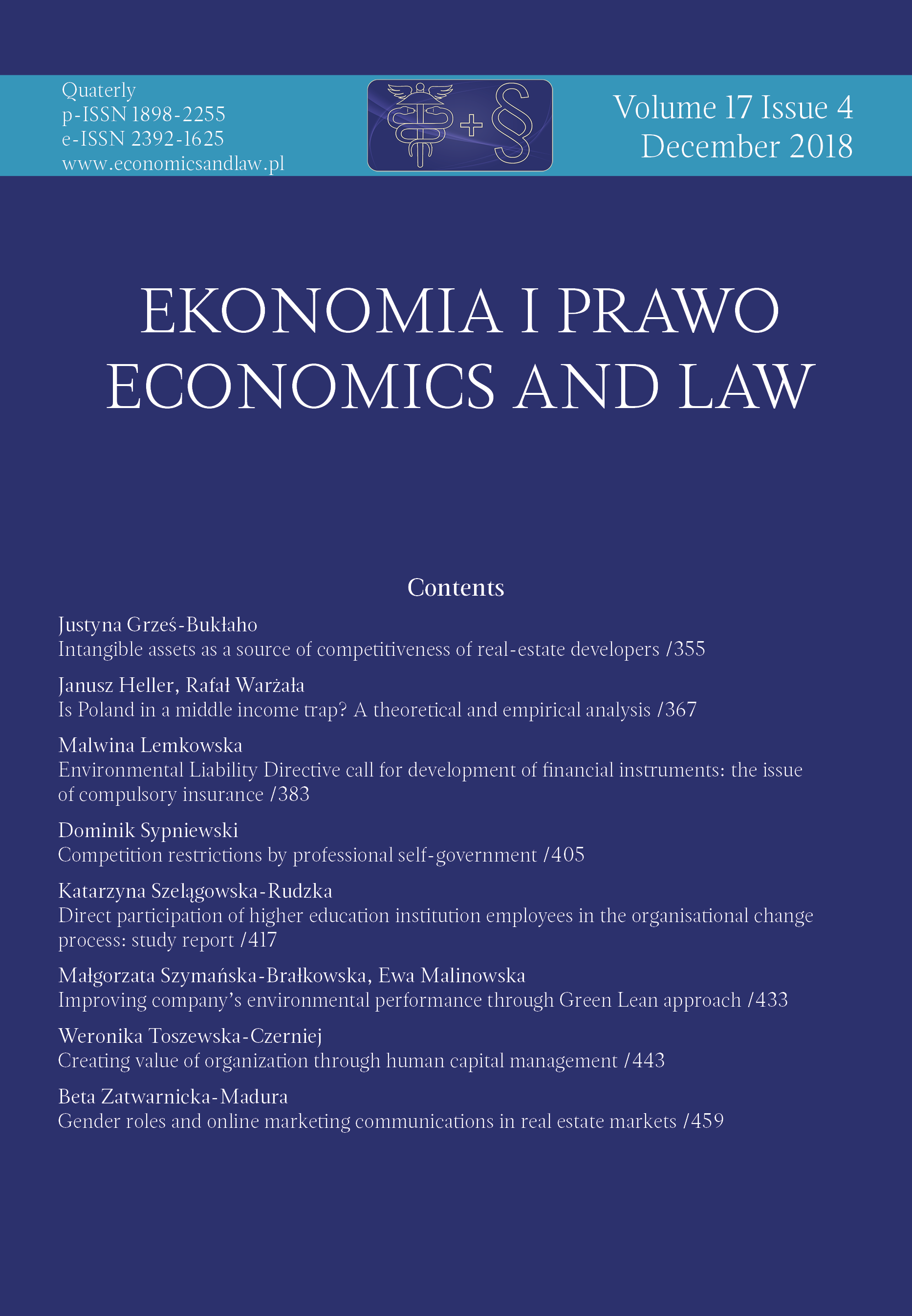Is Poland in a middle income trap? A theoretical and empirical analysis
DOI:
https://doi.org/10.12775/EiP.2018.027Keywords
economic growth, middle income trapAbstract
Motivation: There are many victims of middle economic income trap in the world. This term commonly refers to countries that have experienced rapid growth, which enabled them to reach the status of a middle-income country, but finally have not been able to catch up the developed countries and achieve high-income status. Following this raises the question about Poland’s economy position in the context of middle income trap.
Aim: The aim of article is to present the position of polish economy in the context of ‘middle income trap theory’.
Results: Poland is a middle-income country, and some classifications say it is even a high-income country. The analysis of statistical indicators shows that in Poland there is a problem with the quality of labor, education and competencies, often because of the outflow of talented human capital. Moreover, as is known from the data prepared for the Strategy Europe 2020, Poland has the highest percentage of fixed term contracts in Europe and high poverty at work. Also the low share of the R&D expenditure in the GDP goes together with low sub-indexes of the Global Competitiveness Index and the Index of Economic Freedom. As to the export structure, there was considerable increase in middle and upper technology goods share over the last 20 years.
References
Agenor, P.R. (2016). Caught in the middle? The economics of middle-income traps. Journal of Economic Surveys, 31(3). doi:10.1111/joes.12175.
Aiyar, S., Duval, R., Puy, D., Wu, Y., & Zhang, L. (2013). Growth slowdowns and the middle-income trap. IMF Working Paper, 13(71).
Cai, F. (2012). Is there a ‘middle-income trap’? Theories, experiences and relevance to China. China & World Economy, 20(1). doi:10.1111/j.1749-124x.2012.01272.x.
Ciesielska, D.A., & Radło, M.A. (2014). Determinanty wejścia w pułapkę średniego dochodu: perspektywa Polski. Kwartalnik Nauk o Przedsiębiorstwie, 31(2).
Dingemans, A. (2016). Trying to stay ahead of the curve in Chile’s economic development: exploring a way out of the middle-income trap through pragmatic export development. Development Policy Review, 34(5). doi:10.1111/dpr.12166.
Eichengreen, B., Park, D., & Shin, K. (2012). When fast growing economies slow down: international evidence and implications for China. Asian Economic Papers, 11(1). doi:10.1162/asep_a_00118.
Eurostat. (2017). Database. Retrieved 30.03.2017 from http://ec.europa.eu/eurostat.
Felipe, J., Abdon, A., & Kumar, U. (2012). Tracking the middle-income trap: what is it, who is in it, and why? Levy Economics Institute Working Paper, 715.
Fortunato, P., & Razo, C. (2014). Export sophistication, growth and the middle-income trap. In J.M. Salazar-Xirinachs, I. Nübler, & R. Kozul-Wright (Eds.), Transforming economies: making industrial policy work for growth, jobs and development. Geneva: International Labour Office.
Garrett, G. (2004). Globalization’s missing middle. Foreign Affairs, 83(6). doi:10.2307/20034139.
Gill, I., & Kharas, H. (2007). An East Asian renaissance: ideas for economic growth. Washington: World Bank.
Gill, I., & Kharas, H. (2015). The middle-income trap turns ten. Policy Research Working Paper, 7403. doi:10.1596/1813-9450-7403.
Glawe, L., & Wagner, H. (2016). The middle-income trap: definitions, theories and countries concerned: a literature survey. Comparative Economic Studies, 58(4). doi:10.1057/s41294-016-0014-0.
Hausmann, R., Hwang, J., & Rodrik, D. (2007). What you export matters. Journal of Economic Growth, 12(1). doi:10.1007/s10887-006-9009-4.
Im, F.G., & Rosenblatt, D. (2013). Middle-income traps: a conceptual and empirical survey. Policy Research Working Paper, 6594. doi:10.1596/1813-9450-6594.
Kharas, H., & Kohli, H. (2011). What is the middle income trap, why do countries fall into it, and how can it be avoided? Global Journal of Emerging Market Economies, 3(3). doi:10.1177/097491011100300302.
Wade, R.H. (2016). Industrial policy in response to the middle-income trap and the third wave of the digital revolution. Global Policy, 7(4). doi:10.1111/1758-5899.12364.
Woo, W.T., Lu M., Sachs, J.D., & Chen, Z. (Eds.). (2012). A new economic growth engine for China: escaping the middle-income trap by not doing more of the same. Singapore: World Scientific Publishing Company, London: Imperial College Press. doi:10.1142/8598.
World Bank. (2016a). 2016 world development indicators. Retrieved 15.03.2017 from https://openknowledge.worldbank.org.
World Bank. (2016b). Poverty and shared prosperity 2016. Talking on inequity. Retrieved 16.03.2017 from https://openknowledge.worldbank.org.
World Bank. (2017). Database. Retrieved 08.04.2017 from https://openknowledge.worldbank.org.
Ye, L., & Robertson, P.E. (2016). On the existence of a middle-income trap. Economic Record, 92(297). doi:10.1111/1475-4932.12245.
Downloads
Published
How to Cite
Issue
Section
Stats
Number of views and downloads: 972
Number of citations: 0
